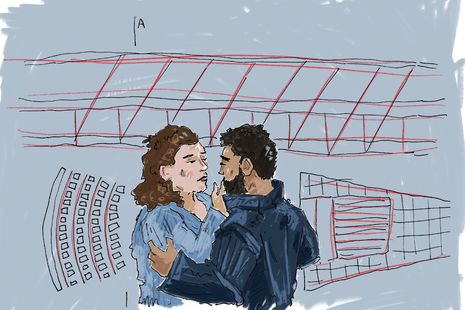When less is more
Bella Ofo unpacks the history of minimalism in theatre

In the darkness of a blackout, a spotlight flickers on. It reveals almost nothing. No elaborate set, no excess – just an actor standing centre stage, alone. In the weight of that expectant pause, something imperceptible stirs. We, the audience, are beckoned through the emptiness of the space, not just to receive the story, but to become active participants in it. The bare world of the play calls itself to us, to unfold itself with us. In a theatrical age of sensory overload, it’s a welcome reminder that perhaps drama doesn’t always live in decoration. Minimalist theatre, and the dramaturgs who experiment with it, often dares to whisper instead of shout, trusting that the bare essentials are enough to move us. But is less always more, or just less? And is what remains enough?
The aesthetic principles of minimalism veer drastically from the elaborate spectacles often found in commercial theatre, instead embracing the architecture of absence and deprivation. A great example is Luis Longhi’s 1999 production of King Lear, held in the fire-damaged ruins of a Peruvian theatre. The ruined state of the theatre became a living, breathing part of the artistic narrative, blurring the boundaries between performer, spectator, and space; immersed in Shakespeare’s world while honouring the theatre’s cultural history.
“Minimalist theatre [...] often dares to whisper instead of shout”
However, to revel solely in its simplicity would be to diminish the practice altogether, disregarding the development of minimalism as a prominent theatrical theory throughout 20th-century European theatre. Sculptor Donald Judd defines minimalism as “the simple expression of a complex thought”. From Jerzy Grotowski’s Towards a Poor Theatre to Heiner Goebbels’ Aesthetics of Absence, minimalism, when done right, is to find so much in so little – to appreciate the rightness and experience of what is left there on stage, not what’s been taken away.
In many ways, it is just as much a spectacle as theatrical maximalism. One of the leading practitioners of minimalism, Peter Brook, thought we must recognise that “the human being is greater than the greatest stage effects”. Thus, these moments of mundanity become extraordinary, essential even. The restrained exhale before a line, the slight shift of weight from one foot to another – all of it becomes theatre. Minimalism pulls you away from the suspension of disbelief, but only to use this alienation to talk directly to you, reminding you that fantasy is located in ordinary experience – in laundry and taxes – not just theatrical replication of the everyday. The immediacy between performer and onlooker reveals something we’ve always known: human connection is what keeps theatre, and us, alive.
However, minimalism nowadays is often measured by its enduring sameness, recycled as a commodified gimmick. Arguably no modern minimalist work receives more commentary on this than The Jamie Lloyd Company. Lloyd’s minimalistic approach encourages audiences to “engage [their] imaginations and become co-authors in the experience”. From the dematerialised voices of Nora’s children in A Doll’s House to immersive multimedia in Evita and Sunset Boulevard, their interpretations often go beyond what one might expect. Yet there is something to be said for taking inherently maximalist ideas and compressing creative impulses into minimalist scaffolding, like some invisible story spine brace where one size fits all. Surely, that is simply less for less’ sake?
“Less can be everything – but only if it challenges us to rethink what truly matters on stage”
When ineffective, the potent immediacy of theatre is lost and the audience is reminded that we don’t exist between plain black and white walls, but in living colour, relative to the world around us, which doesn’t always fit so neatly within a proscenium arch. Minimalism becomes a paradox, expanding and contracting depending on who touches it. So how can we approach minimalism beyond the stage as an empty canvas waiting for the audience to fill in the blanks?
Perhaps it’s time to move away from viewing minimalism as a choice that suits every production and instead as a stylistic tool that manipulates a space and the people within it. Minimalism should be one piece of the visual direction, an intentional dramatic choice that in isolation is never anything more than that. Once again, Longhi’s production of King Lear comes to mind. Here, the intersection between performance and architecture shows minimalism’s potential to go beyond the material, creating a cultural moment and theatrical experience that enriches the audience.
Less can be more – in fact, less can be everything – but only if it challenges us to rethink what truly matters on stage. It is felt most as a quiet rebellion, in moments that ask us to lean in, to imagine, to feel deeply, or when it simply asks nothing at all. And in all that stillness, the world offers itself back to your imagination, shaping you as much as you shape it.
 News / Cambridge students accused of ‘gleeful’ racist hate crime4 December 2025
News / Cambridge students accused of ‘gleeful’ racist hate crime4 December 2025 News / Churchill announces June Event in place of May Ball3 December 2025
News / Churchill announces June Event in place of May Ball3 December 2025 News / Uni redundancy consultation ‘falls short of legal duties’, unions say6 December 2025
News / Uni redundancy consultation ‘falls short of legal duties’, unions say6 December 2025 News / Cambridge cosies up to Reform UK30 November 2025
News / Cambridge cosies up to Reform UK30 November 2025 Comment / Don’t get lost in the Bermuda Triangle of job hunting 24 November 2025
Comment / Don’t get lost in the Bermuda Triangle of job hunting 24 November 2025









